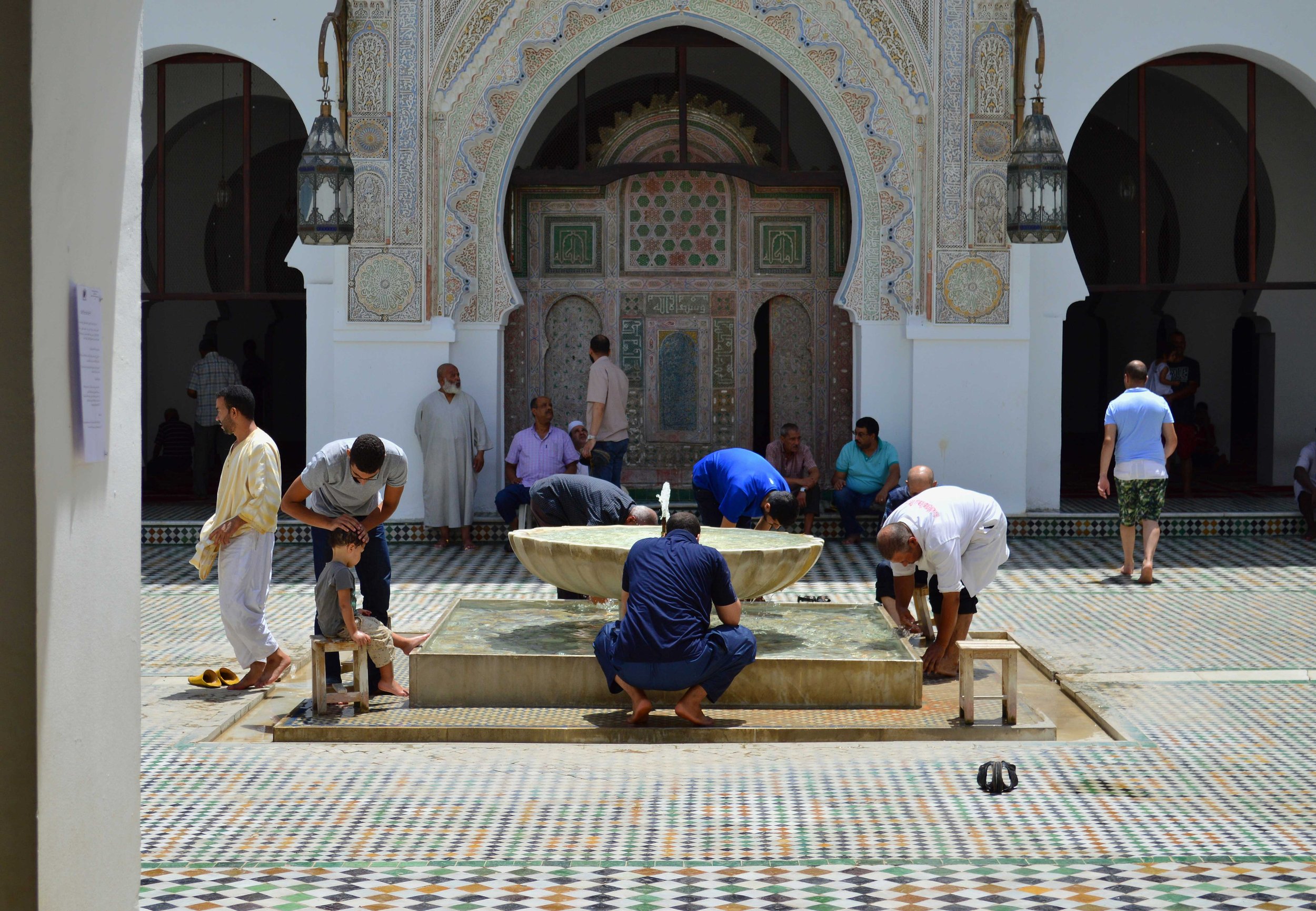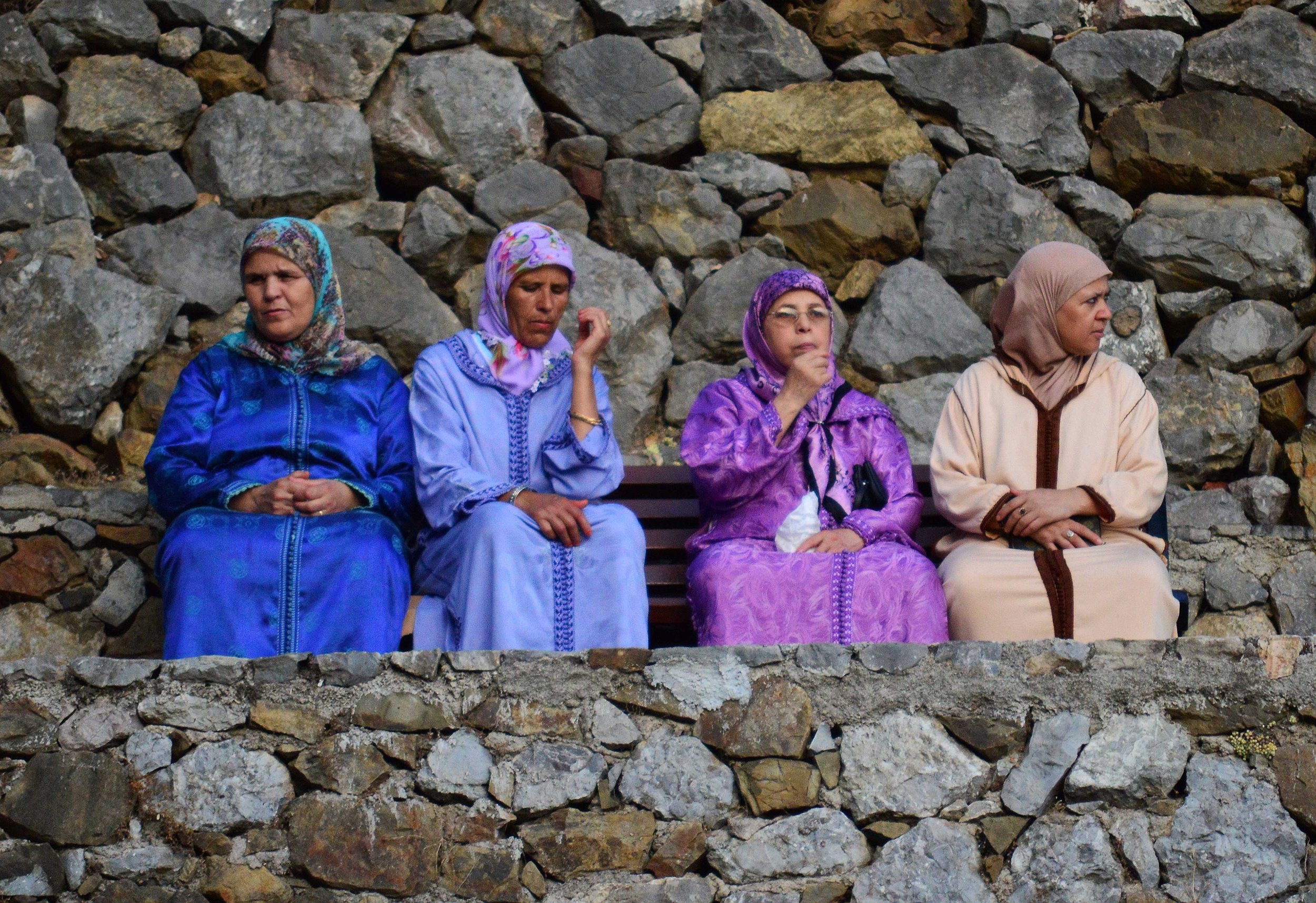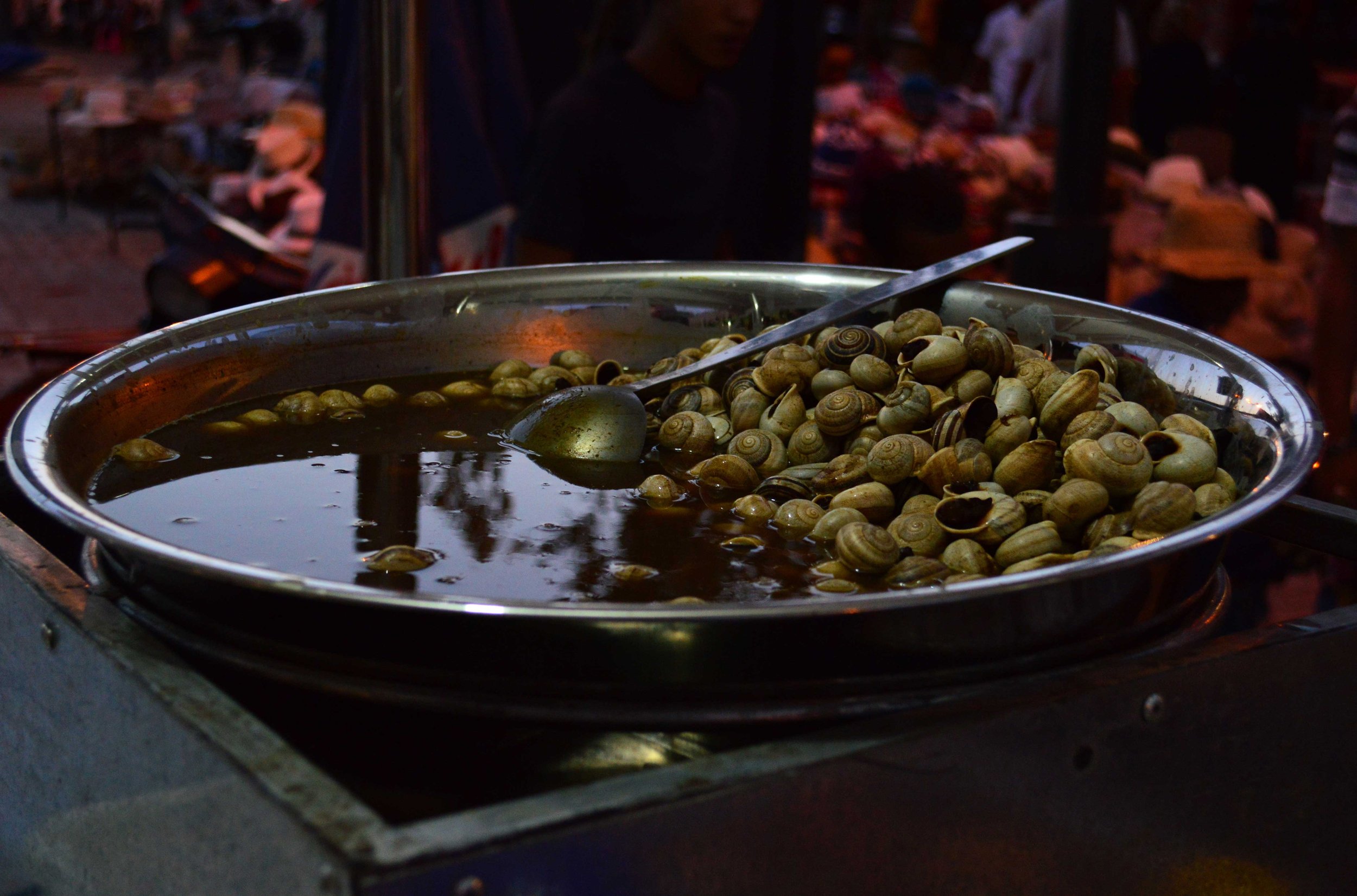MOROCCO
Casablanca • Rabat • Moulay Idriss • Volubulis • Meknes • Fez • Chefchouen • Tangier • Marrakesh
In 2016 I spent a couple of weeks touring some of the cities and larger towns of northern Morocco. My previous trip to the country had been with a friend, and we had tried to find our own way around with mixed success. This time I had a guide, lovely Abdou, who showed me the best places to eat and see and kept me out of trouble.
I had an unpromising start to my trip. The Royal Air Maroc flight was delayed, and the lounge was heaving with people waiting. However I ended up with a window by the exit so I had great views and plenty of leg room. I was able to see the whole of Spain passing underneath – I had no idea it was so mountainous. I arrived in Casablanca late so wasn’t able to see much of the city although I could tell it was big and modern. It’s much more industrialised than I had imagined. I clearly watch too many movies.
We took an early morning train to Rabat and spent the day wandering about the kasbah that led to an overview of the busy beach. The city is divided where the river Bou Regreg flows out. The northern side is Salé and has a different character but the beach looked just as busy. I’m sorry that I didn’t spend enough time in either Casablanca or Rabat to discover their hidden charms. I’m sure they both have more interesting stories than I was able to discover in a couple of days.
Majid (left) was our guide in Moulay Idriss and what a character he is. Everybody we passed knew him and he knows all there is to know about the town. He insisted on posing like a supermodel for his photo. I’m not sure if he pulls it off! On the right is Abdou who shepherded me around until we got to Marrakesh. In honour of both, I bought a pair of Moroccan leather slippers – mine are black though, I wasn’t brave enough for red.
Another train – this one a proper old-fashioned one with compartments and overhead nets for luggage, and then a taxi to Moulay Idriss. It’s a holy place, with many religious festivals, and It’s only very recently that non-Muslims have been allowed into the town. I had no idea what to expect but it turned out to be the friendliest place we went to. A lot of the religious towns/cities seem to have a signature colour. It was green in Moulay Idriss, the colour of Islam.
The first place Majid took us was to the bakery. The beating heart of a Moroccan town, he told us, this is where you find out what’s going on. As in other parts of Morocco, the bread is baked in ovens that heat water for the hamman above.
I had been warned that the accommodation would be very basic but the La Colombe Blanche was family-run, and lovely. I had a room right at the top on the terrace that I shared with a group of tortoises. For dinner the family made us a delicious meal of meatballs with something like an omelette on top, and lots of vegetable couscous.
Outside of Moulay Idriss, are the ruins of Volubilis, an old Roman city. I do like a good ruin, and this is one of the best with baths, roads, mosaics and a basilica. The fancy mosaics and decoration show that it had been once very prosperous probably due to many olive tree cultivation on the land around. So much of this site remains unexcavated. Like many sites in Turkey, they do not have enough funds not only for the archaeological work, but also to protect it afterwards. It’s much safer remaining unearthed for future generations. That’s a comforting thought in a demanding, impatient world.
We moved on to another imperial city, Meknes, once the capital of Morocco under Sultan Moullay Isma’il who built a huge palace complex. Although most of what remains is crumbling, there is still a lot to see here.
I very much liked the Heri al-Mansur palace and the vanishing point effect of what were thought to be the original stables for the sultan’s 12,000 horses. Its purpose has been disputed however, and it was more likely a grain store. As with many of the world’s great historic structures, it was believed that thousands of slaves were used to build the palaces of Meknes. If the stories about him are to be believed, Moulay Isma’il was one of Morocco’s greatest villains. He was brutal, killing over 20,000 people during his reign, and liked to wear yellow on his bloodiest days. He fathered over 800 known children by his harem of over 500 women. There was also a story about how much he admired Louis XIV and had modelled some of the palace on Versailles in hope of marrying his daughter. It’s hard to know how true some of these stories are, but he was definitely a bit of a shit.
Camel burgers in Meknes. It was ok but I wouldn’t have one again (unless I was lost in the Sahara). I liked the charm of the little hole where we sat and ate them, and the friendly guy making them. It was a bit disappointing to find out this place is owned by a Brit.
Pink seems to be the accent colour of the medina of Meknes.
An overview of Fez from a nearby hill shows how big it is, and most of this is the medina, the best in Morocco and one of the biggest urban pedestrian areas in the world. I loved this city more than any other. It felt ancient and complicated, but very alive if a little intimidating.
Everybody seemed very busy in Fez. In the medina, aside from the shops and market stalls and the men with pulley carts shouting ‘balak' at me (‘get out of the way’), there were lots of artisans practising their craft, like these two dyeing cactus silk thread.
The men who worked in the leather dyeing vats made their feelings very clear about being used as a tourist spectacle, and tried to put us off watching them by reflecting sunlight at us via a mirror. Some of the vats contain pigeon shit and some cow urine, both of which are traditional parts of the leather tanning process so inevitably the whole place stinks – I can’t blame them for getting irritated by gawpers.
Drainage ditch outside the tannery.
Wudhu (ablutions) before prayers in the courtyard of the Mosque al-Qarawiyyin.
There were carts selling prickly pears where, luckily, someone with thick gloves was on hand to cut them up. Very delicious.
The small but perfectly-formed ‘School of the Perfumers’ the Al-Attarine Madrasa, so named as it was originally in the spice and perfume souk. It was built by the Marinid sultanate along with many other buildings in what became the 'golden age’ of Fez. A testament to what beauty and elegance can be achieved when the warring dynasties were at peace, it’s my favourite madrasa so far. I would have loved to have gone to the re-opened library, but they only started admitting visitors after my trip.
A ‘small’ lunch for two. I would never have found Le Patio Bleu in Fez deep inside the labyrinthine medina without help. Here are the accompaniments to a chicken tagine and caramelised onions which was delicious. Later on we had dinner in a family house that becomes a restaurant at night. All the food is cooked by the family and the highlight was a pigeon pastilla – meat pie dusted with icing sugar. I was already a pastilla aficionado from a previous trip to Morocco but this was my first pigeon one, and it was delicious.
Peace away from the Medina at the Dar Batha museum which was once a royal palace, but now houses all kinds of beautiful antiquities. It also has luscious, people-free gardens.
After Fez came Chefchouen – the ‘Blue City’. Nestled in the Rif mountain range, it doesn’t even try to blend into its landscape. I find it amazing that just about everyone has agreed to paint their wall, doors, even plant pots blue. And not just any blue, a beautiful powdery mid-blue. There are several theories why this has happened and nobody is really sure, although some cynics say it was done purely to entice tourists. When I went there, there were visitors from all over the world, but the vast majority of tourists were the Moroccans themselves who love the place. I don’t like crowded places, but I was quite happy here.
This is literally the view from behind our hotel – straight up into the Rif mountains. Below is the Casa Aladin where we ate a couple of times.
There were so many people offering henna hand painting but I went rogue and had my lower legs painted by this lovely lady outside of the medina.
A special moment listening to the call to prayer as the sun set over Chefchouen.
A bus ride to Tangier and a very different vibe. I loved the American Legation building which was once a consulate but now a museum. There is a whole section dedicated to Paul Bowles, a favourite author, who lived here for over 50 years, and who had everyone who was anyone to stay with him.
Tangier has a very cool shabbiness. Even the well-know cafés, like the Gran Café de Paris, the Café Hafa and the Café Baba don’t look much from the outside but have an amazing combined list of past patrons – William Burroughs, Patricia Highsmith, Tennessee Williams, Matisse, and of course Paul Bowles as well as rock stars and poets. I like the Café Tingis best for its people-watching terrace, tiles and mint tea. I later went dagger shopping in the many antique shops in the Kasbah. In many ways, Tangier is the more exotic cousin of Brighton.
View from the top of the Tangier Kasbah - the vague hint of land mass in the background is Spain. Afterwards I had cocktails in the Hotel Rif with Abdou who told me some horror stories of previous tours he had led, and I was glad I had him with me.
I was very excited to be travelling on the Marrakesh Express. The reality wasn’t as romantic as I had hoped for, but it was definitely an adventure. We left Tangier late evening. The cabin had four bunks and we were given just a sheet. I travel with a small pillow anyway and a silk sleeping bag liner so I could make myself comfortable. There were no bathing facilities but you’re only on the train a few hours so that was fine. The toilet was the classic hole in the ground sort and quickly deteriorated overnight as they always do. When we left it was too dark to see anything. I had hoped the motion would lull me to sleep but I barely slept at all. This was not helped by an engine change in Casablanca (I think) at about 1 in the morning. There was an awful lot of shunting going on trying to attach the new engine. In the end I gave up on sleep and spent the last few hours in the corridor watching the sun come up over the Sahara with the other non-sleepers.
We should have arrived about 8, but a ‘broken-down train in the Marrakesh area’ meant we stopped at a station for a couple of hours. I asked Abdou if I could get off and buy some breakfast from the stand on the platform. He warned me that if the whistle went, the train would leave without me so it was risky. I risked it, bought a roll, a boiled egg and some fruit juice. The whistle went as I was dashing back and I just made it!
Arriving in Marrakesh was like opening an oven door. It was insanely hot. I said ‘goodbye’ to lovely, patient Abdou and spent the last couple days on my own. I stayed at the Riad Kohl (now the Riad Zhor) in a quiet street but I had been given a room called ‘Noir Poudre’ and everything in it was black – it was like sleeping in a coffin! I had chosen it for their beautiful hamman but it was temporarily closed which was a disappointment. Still they were very friendly and helpful, and it was in a good central position near the Ben Slimane mosque.
I had learned from my last trip here, that you need to keep yourself under the radar as you wander the medina. This time my camera stayed in my bag, I wore sunglasses, and walked purposefully like I knew where I was going even when I was lost. I accidentally walked out of the medina a couple of times but just walked back in and tried again. If you look confused or helpless for a second, someone will notice and that’s not always a good thing.
The lady at the riad warned me to be careful today as the temperature was 51° centigrade, and I could feel the top of my head burning when I stepped out of the shade. Really this was a day to stay inside, but I wanted to go back to the Maison de la Photographie as I am a big fan of the photographs of Nicolás Muller. They also have a fantastic shaded café on their roof where they serve delicious cold drinks. Of course I was the only idiot up there in the heat, but that meant I got to enjoy my lemon and mint drink and strawberries in peace.
Afterwards, as the temperature dropped to a cool 46°, I made my way to the Jemaa el-Fna to join what turned out to be one of the best food tours I had ever done. We had two guides both of whom had grown up in the medina, and knew everyone. The evening was a mixture of eating incredible food and learning so much about how the food culture evolved and how economical it was. Like in Moulay Idriss, the fires that heat the hamman are used to cook stews and bread. Locals bring their dough or stew-filled tangia pot in the morning, and pick them up later.
I also love that they eat everything – I ate sheep’s head (very tasty, particularly the cheeks) and spleen (not unpleasant but no idea why I was eating it), as well as the delicious babbouche (snail soup). It made me realise how remote and wasteful the food culture of England is. We went down a few dark streets to watch couscous being made from scratch, and then were given huge plates of it. I even tried a bit of a Moroccan doughnut despite having a dislike of them generally.
I had been told to make sure I was starving hungry before this tour and they weren’t joking. I was stuffed by the end but found room for the date milkshake (the best flavour I have ever had) and some pastries including briwat and ka’ab ghazal. A few people had dropped off the tour during the evening (one couple left abruptly at the sheep’s head bit), but I was pleased I had seen it through. I have recommended this tour to other people since who also loved it, but annoyingly, I cannot find a link on the interweb anymore. I hope they are still going strong.
I also revisited the Jardins Majorelle again. I had been there before but it had been crowded and busy. The Riad Khol was a short walk away so I got up very early and made sure I was the first through the doors. The gardens are lovely when you have them to yourself but it’s the Berber museum that I really love, and its fantastic jewellery collection which I wasn’t allowed to photograph.
What a great time I had in Morocco. There’s so much to see and experience and I felt like I had done a lot. But I need to come back and explore the south of the country and I’d also like to go back to Fez and get properly lost in the medina.


























































